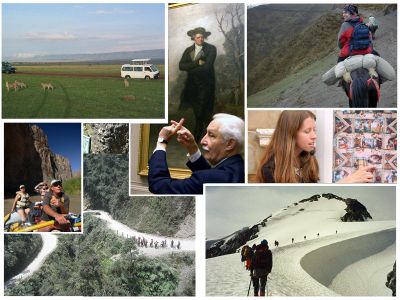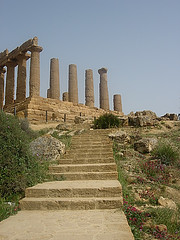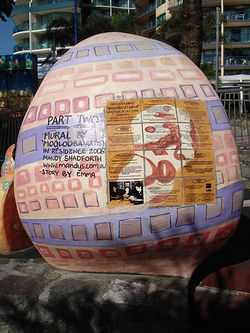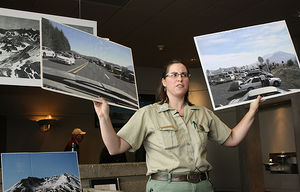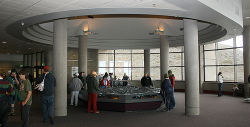Tour Guiding
| Course Blog |
|---|
Tour Guiding Course BlogFailed to load RSS feed from http://tourguiding.wordpress.com/rss.xml|Date|short|max=3: Error fetching URL: Maximum (0) redirects followed |
- A tour guide is a person who leads groups of people around a town, museum, or other tourist venue. The tour guide provides a commentary on the features and history of the location, the tours can be from as little as 10-15 minutes to extended periods over many days. Considerable importance is placed on the guide's knowledge of local stories, history and culture depending on the location of the tour." Wikipedia:Tour Guide August 2007
This is a course for learning or refreshing yourself with the skills and duties involved in tour guiding for a tourism organisation. Below are the areas available for study. Each area has a range of learning objectives with a variety of learning activities and web resources. If you find a good resource please add it to the resources listed in each area. If you have an idea for a new activity please add it to the activities list for the unit. Feedback for this course is welcome on the discussion page. Read the Course guide to gain a better understanding of the requirements of the course - the learning outcomes are listed below.
Contents
- 1 Tour Guiding Course Blog
- 2 This course is used in the following programme
- 3 Learning Support
- 4 Prepare and implement an interpretation plan
- 5 Manage health and safety and first aid in an emergency situation
- 6 Demonstrate leadership skills in a tourism context
- 7 Demonstrate an introductory knowledge of the New Zealand native flora and fauna and key geological process
- 8 Skills
- 9 Administration
This course is used in the following programme
Learning Support
The following services are available for offering learning and assessment for this course:
- Otago Polytechnic offers learning support and assessment services through the Tour Guiding course weblog
- Course schedule - a time table for when the next course will start and the periods in which the study will be supported by teachers and learning facilitators.
- Course guide - outline of course requirements and assessments
Prepare and implement an interpretation plan
People credited with this course; preparing and implementing an interpretation plan for New Zealand attractions, activities and events (focused on our local region), are able to: describe the principles of interpretation and describe and compare personal and non personal interpretation.
What is interpretation? Its a means of communicating ideas and feelings which help people understand more about themselves and their environment. There are many different ways of communicating these ideas, including guided walks, talks, drama, displays, signs, brochures and electronic media. Our first task will be to look at the process of interpretation starting with the topicYour Place. As you can see this is a progressive activity so in the first instance we only do the first two parts. Remember to keep a record of where you got your information. In the third part we gauge if or how well we have incorporated Tildens Principles of Interpretation. Just in case you are needing some clarification - here is an interpretation of these principles. So lets go back to the "Your Place" activity and see if we can make it even better than it was - so that when you deliver it out we can see you have applied all the principles.
Site
Sites have something to say to a visitor....interpretation provide the intimate connection. Whether its Orokounui or the northern cemetary the site not only provides the topic/theme for the interpretation but acts as a catalyist in its delivery.Good interpretations use myths and legends to help us gain spiritual and personal connections to sites eg. historic sites, dramatic scenery, battlefields. The more you know about your site the easier it makes the planning and delivery of your interpretation.
Interpretation is about special places or sites, however this term is generic and can mean anything from; a building, countryside, a town, an aspect of cultural life or a tradition , an object, an historical event, an activity. As Tilden explains...interpretation not only tells visitors what is important/interesting about a place but aims to convince visitors of its values and the need to conserve it.
Signs
Signs are often described as another form of communication used to provide information to visitors and clients? They can of course be more than this. Signs; inform, warn, guide, identify and interpret. Lets look at some examples of "signs". Signs are commonly used in parks, forests, zoos, cultural sites. What are some of the advantages and limitations of using signs.
How many universal symbols can you think of and why are they so effective?Information boards on tracks are often used to communicate rules and warnings. They must command attention and appeal for people to take notice of them. These types of signs are usually linked to the health and safety of visitors and clients.
Complete the activity signs and then answer the questions.
Interpretive Panels
Interpretive signs are static objects in a dynamic environment. What do we mean? The sign, panel, information board is competing with the environment, sunshine, rain, flora and fauna. Visitors must feel that reading these signs is worth the effort. Why would visitors look at them? The sign must communicate its message quickly and dramatically and relate to what the visitor will see or experience.Seven ways to effective message:
1. say it visually - use photos and drawings to help tell the story
2. graphics should do more than duplicate what can be seen. They should reveal hidden meanings and ideas
3. use a message pyramid - 3-30-3 rule
4. keep the message short - make sure the readibility scale is not too high eg. write to your intended audience
5. Creat imagery with concrete nouns and active verbs - limit adjectives
6. Relate to the visitor's experience. Use personal pronouns, personal language and familiar terms. Illustrate with metaphors, analogies, quotes, and real examples
7. Provide for multi-sensory involvement. Use audio eg. bird calls, touching eg. putting your hand in a box touching objects to idenify them, maps (Te Papa), tracks with indicators.
Now look at your own environment - complete this activity interpretive signs then present it back to your fellow students.
Interpretive Centres
Visitor centers serve as portals to a "spirit of place." They are facilities that prepare visitors physically, and mentally to experience a special place and ideally guide people to a "sense of place".- they welcome visitors and provide for their physical comforts and needs eg. cafe, toilets
- they orient and inform
- they inspire and instill reverence and awe for the features and events of that special place
Mt St Helens in Washington State, USA offers visitors the opportunity to view five different Mt St Helens visitor centres. The story of Mt St Helens covers a variety of themes - death and rebirth, destruction and renewal all with intense human interest and drama. In an effort to explain this site further and define the value of interpretive centres complete this centre activity.
Testing your knowledge
Your main assessment for this section of the course (interpretation) centres around a roving interpretation where you get to display not only your interpretation skills but also your leadership skills. This information sheet may help.
Your second assessmenttakes into account the different techniques of interpretation and their strenghts and weaknesses. We have been working through a glossary of terms on the blog which you should use as a resource.
Manage health and safety and first aid in an emergency situation
The tour guiding and adventure tourism professions are undergoing a period of significant change. It is important that future tour guides are fully conversant with best practice when it comes to safety management. This is the focus of this part of the Certificate. Through this unit people will be able to demonstrate knowledge of risk management theory; explain the health and safety roles and responsibilities of an individual working in a tourism organisation; demonstrate knowledge of the health and safety policies and procedures of a tourism organisation; and identify, record in writing, and take action on potential risks and hazards in a tourism activity.
Demonstrate leadership skills in a tourism context
In this unit you will learn how to describe a range of leadership styles, and identify leadership styles for specified tourism contexts; and demonstrate interpersonal skills when leading in a group situation.
Demonstrate an introductory knowledge of the New Zealand native flora and fauna and key geological process
Tourists have an expectation that they will be hosted by knowledgable tour guides who have a unique way of delivering information. This local course will give you the opportunity to both gain important knowledge in respect of New Zealand's unique geology, climatic zones, wildlife, plants and trees. The assessment will also provide you with plenty of practice in developing and perfecting your presentation skills.
Skills
Technology and Weather Interpreation in Tour Guiding
The ability to be familiar with and use a wide range of technology is becoming more and more important for tour guides, particularly those who venture into the great outdoors (e.g. two way radios, map and compass, GPS, Personal Locator Beacons). This part of the course will introduce you to these pieces of equipment.
Often thise technology is required when things do not go to plan and the weather can have a major part to play in this. As with most things, prevention is better than cure so with that in mind we will also introduce basic weather interpretation - both when you are out and about and when you are looking at the weather map in the local newspaper. This knowledge will lessen the risk of you being caught out unprepared.
Prepare and serve a hot and cold non-alcoholic beverage
In this unit you will learn how to prepare for service hot and cold non-alcoholic drinks, and serve hot and cold non-alcoholic drinks in a commercial environment.
Demonstrate basic food handling skills
In this unit you will learn how to maintain effective personal hygiene when working with food as per establishment requirements; Prevent cross contamination in a food business; measure, record, and act on temperature of high risk food.
Administration
Below is a page generator that will initiate templates for a new Learning Objective and its two sub pages called Resources and Activities. Please type the title of your learning objective in the box below
